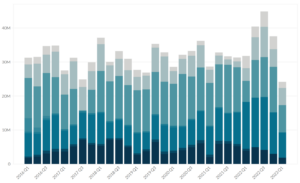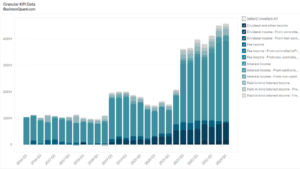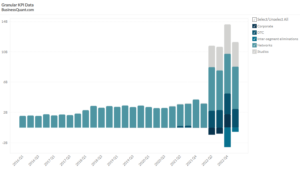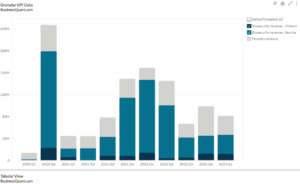
Truist Financial’s Revenue Breakdown by Business Vertical (2016-2023)
Exclusive Data
You need the Pro Plan to access KPI data
- Full access to the platform
- KPI data & segment financials on US stocks
- Financial data on thousands of stocks
- Download data in xlsx and csv formats
Pro Plan
$49 per month*
60% discount ends in:
.
About
More information
Subscribe to Pro or Enterprise plans to unlock this feature.
Contact the Analyst
Subscribe to Pro or Enterprise plans to unlock this feature.
Become a smarter investor today.
Access KPIs & Segment Financials on US stocks
This statistic highlights Truist Financial’s Revenue Breakdown, split across Interest Income and Non-Interest Income, and reported on a quarterly basis starting from 2016 onwards.
Truist Financial’s Revenue Breakdown by Business Vertical
As a result of BB&T and SunTrust Banks’ merger in December 2019, Truist Financial Corporation was created. The revenue of Truist Financial Corporation can be divided into Interest Income and Non-Interest Income. Two of the key elements of a bank’s income statement are interest income and non-interest income. A bank’s income from lending money is known as interest income, but its income from other sources, such as fees, investments, and other unrelated income, is known as non-interest income.
The given below table shows us the revenue distribution by the business vertical of Truist Financial Corporation.
| Item | 2022 Q3 | 2022 Q4 | 2023 Q1 | Revenue Mix Breakdown from year Q1 2023 |
| Interest income | 4,36,90,00,000.00 | 5,23,80,00,000.00 | 5,78,50,00,000.00 | 72% |
| Non-interest income | 2,10,20,00,000.00 | 2,22,70,00,000.00 | 2,23,40,00,000.00 | 28% |
| Total | 6,47,10,00,000.00 | 7,46,50,00,000.00 | 8,01,90,00,000.00 | 100% |
(All figures in USD except percentages)
As we can see, the company’s revenue has increased during the previous three quarters. The revenue mix for Q1 2023 is anticipated to have a higher amount of interest income. The company’s growth from Q4 2022 to Q1 2023 was 10.44%. In addition, whereas non-interest income made up 28% of Q1 2023’s revenue distribution, interest income made up 72% of it.
The revenue distribution through business vertical has been divided into 2 parts:
Interest income
The main source of income for banks is interest income. It is produced by the difference in interest rates that exists between the interest rates that banks pay on deposits and the interest rates that they charge on loans. Banks can generate more interest income from their loans when interest rates are rising, which could result in increased profits. Interest from loans, interest from securities, and interest from other sources are all included in Truist Financial’s interest revenue.
Non-Interest Income
Banks also receive non-interest income, which is not as significant as interest income. Non-interest revenue is less dependable than interest income and can be erratic. Non-interest revenue, however, can aid banks in balancing losses brought on by falling interest rates. Fees, investment income, and other unspecified income are included in Truist Financial’s non-interest income.
About Truist Financial Corporation
A financial holding firm with its main office in Charlotte, North Carolina, is called Truist Financial Corporation. Truist Financial, with $574 billion in assets as of March 31, 2023, is the sixth-largest bank holding corporation in the United States.
Individuals, companies, and institutions can choose from various financial products and services Truist Financial offers. Checking and savings accounts, credit cards, loans, investments, insurance, and retirement planning are some of these goods and services. With more than 2,000 branches and 3,000 ATMs, Truist Financial is well-represented in the southeast of the country.
Serving its clients and the communities it lives in is important to Truist Financial. The company has a number of programs in place to assist financial literacy and economic development. For instance, Truist Financial collaborates with neighborhood groups to support economic development initiatives while also offering financial education programs to adults and students.
Did you like Truist Financial’s Revenue Breakdown statistic?
Access more such KPI data points and segment financials on thousands of US stocks, with Business Quant.
You can get started here.
More data on US Stocks

Our Plans
Always know what you’ll pay. No hidden costs or surprises.
- Annual
- Monthly
60% discount till April 30
Pro
For serious investing
-
Company KPI data Access segment financials, non-GAAP metrics and KPI data from presentations and filings. Examples include financials by segment / region / product category, AT&T's broadband subscriber trends, Tesla's deliveries by model and lots more.
-
Stock research tools Features include : stock screener, stock comparison, industry financials, stock warnings, advanced charting tools, timeseries tables, scatter charts, financial statements, stock reports, SEC filings, stock ratings, institutional and insider ownership data. There are 200+ financial items and ratios on thousands of US stocks.
-
Industry data & tools Access premium operating data on 40+ industries. Examples include market share, smartphone shipments by vendor, subscribers by wireless carrier, historical gold production. There are 20,000+ such statistics.
Enterprise
For tailored workflows
-
All of Pro plan Get unfettered access to all our dashboards and dossiers.
-
Custom built features Get tailored dashboards built specially for you , based on your set of requirements, to simplify your research workflow.
-
Admin billing Back-end documentation support and multi-seat licensing.
* Billed annually, local taxes extra.
60% discount on Annual plan
Pro
For serious investing
-
Company KPI data Access segment financials, non-GAAP metrics and KPI data from presentations and filings. Examples include financials by segment / region / product category, AT&T's broadband subscriber trends, Tesla's deliveries by model and lots more.
-
Stock research tools Features include : stock screener, stock comparison, industry financials, stock warnings, advanced charting tools, timeseries tables, scatter charts, financial statements, stock reports, SEC filings, stock ratings, institutional and insider ownership data. There are 200+ financial items and ratios on thousands of US stocks.
-
Industry data & tools Access premium operating data on 40+ industries. Examples include market share, smartphone shipments by vendor, subscribers by wireless carrier, historical gold production. There are 20,000+ such statistics.
Enterprise
For tailored workflows
-
All of Pro plan Get unfettered access to all our features.
-
Custom built features Get tailored dashboards built specially for you , based on your set of requirements, to simplify your research workflow.
-
Admin billing Back-end documentation support and multi-seat licensing.
* Local taxes extra.






